University Essay: Perspectives on Capital, IC51002A
VerifiedAdded on 2022/08/11
|10
|2215
|18
Essay
AI Summary
This essay provides a comprehensive analysis of perspectives on capital, focusing on the theories of Karl Marx and Robert Putnam. It begins with an introduction to the concept of capital, differentiating between financial, human, and social capital. The essay then delves into a literature review, exploring the approaches of human and social capital theories, and compares their characteristics. The core of the essay examines Marx's perspective on human capital, contrasting it with Putnam's view of social capital, including their definitions, characteristics, and importance. The discussion highlights the interrelation between the two forms of capital. The essay references key publications like "Bowling Alone" by Putnam, and explores criticisms of both theorists' arguments, including the measurability of human capital and the oversimplification of social capital. The conclusion summarizes the key points and offers a critical perspective on the strengths and weaknesses of each theory, providing valuable insights into the complexities of capital in economic and social contexts. The essay is a student contribution, and it is available on Desklib, a platform that provides AI-based study tools for students.
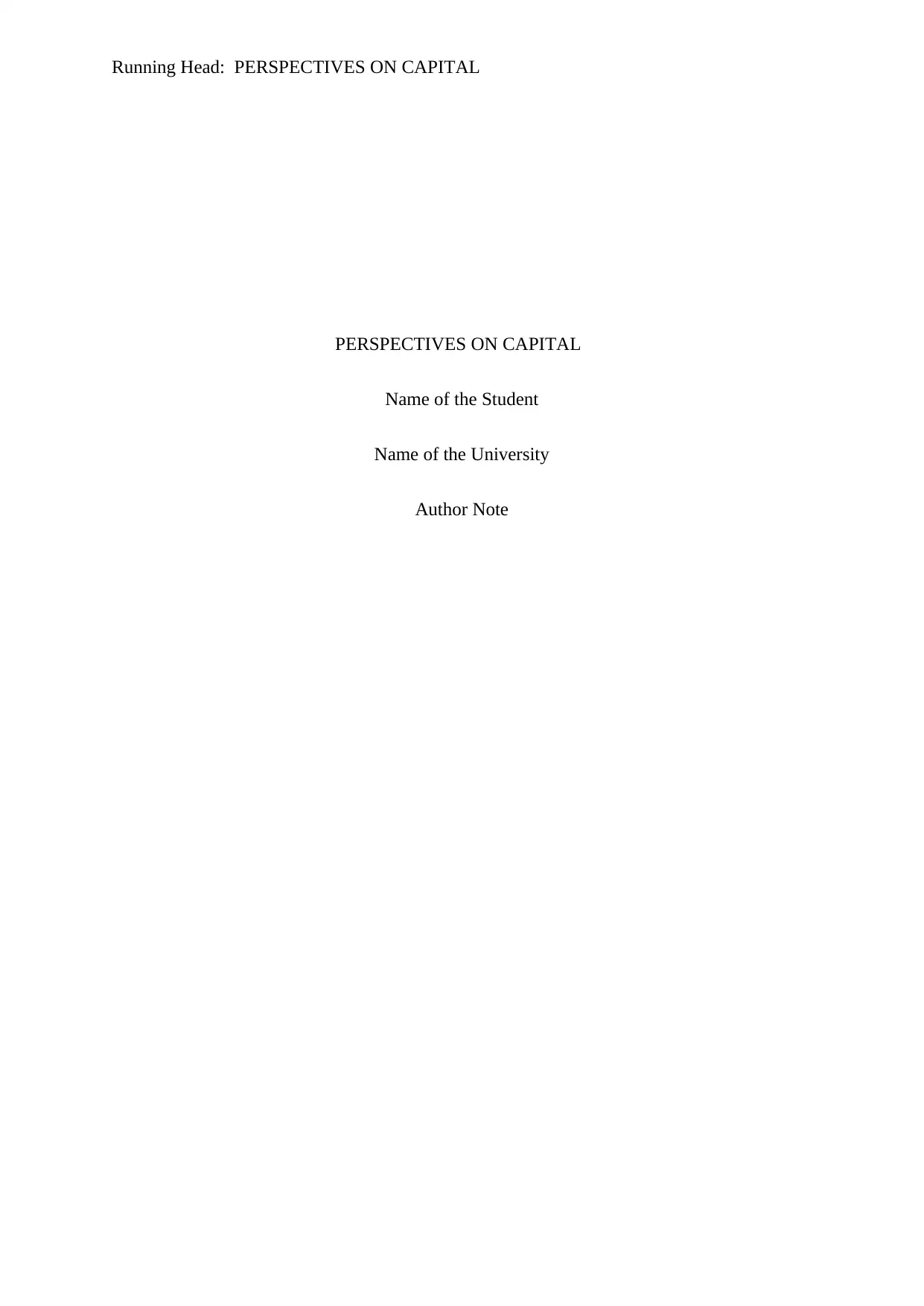
Running Head: PERSPECTIVES ON CAPITAL
PERSPECTIVES ON CAPITAL
Name of the Student
Name of the University
Author Note
PERSPECTIVES ON CAPITAL
Name of the Student
Name of the University
Author Note
Paraphrase This Document
Need a fresh take? Get an instant paraphrase of this document with our AI Paraphraser

1PERSPECTIVES ON CAPITAL
Table of Contents
Introduction................................................................................................................................2
Literature Review.......................................................................................................................2
Approach of “Human Capital” & “Social Capital” Theory.................................................2
Comparison between “Human Capital” and “Social Capital”..............................................3
Conclusion..................................................................................................................................6
Reference....................................................................................................................................7
Table of Contents
Introduction................................................................................................................................2
Literature Review.......................................................................................................................2
Approach of “Human Capital” & “Social Capital” Theory.................................................2
Comparison between “Human Capital” and “Social Capital”..............................................3
Conclusion..................................................................................................................................6
Reference....................................................................................................................................7

2PERSPECTIVES ON CAPITAL
Introduction
Capital is term for the financial assets, for instance funds held in the deposits accounts
or funds obtained from the special sources of financing. Further, human capital theory is
dominant approach for the understanding of personal distribution of income. It is intangible
asset or the quality, which is not listed on the organization’s balance sheet. This can be
segregated as economic value of worker’s experience and skills. Moreover, question is
whether human capital approach helps in making people more productive that leads towards
higher income. However, in reality, this is not the case. In most of the cases, theory of human
capital is either not supported by the evidence and is so vague that it is not possible to test
and the theory is based on circular reasoning. Contrary to the concept of human capital, social
capital is networks of relationship among the people, who work and live in the society that
enables them for functioning effectively (Fleming 2017). Hence, this paper will include the
critical discussion on perspective of Marx on the human capital and on the perspective of
Putnam on social capital. Further, discussion will be on the way both the capital is
interrelated with each other.
Literature Review
Approach of “Human Capital” & “Social Capital” Theory
The idea of the theory of human capital is credited by founding father of the
economics, Adam Smith, who stated in 1776 that the useful and acquired abilities of all
members or inhabitants of society. He suggested that the differences in the payment of wages
are based on difficulty or relative ease of the involved job. Further, Karl Marx in 1859, called
it as labor power and suggested idea of the human capital with the help of asserting that in the
capitalist systems, labor power is sold by people-human capital in exchange for the income.
In comparison to the Adam Smith and the other former economists, Marx has pointed two
Introduction
Capital is term for the financial assets, for instance funds held in the deposits accounts
or funds obtained from the special sources of financing. Further, human capital theory is
dominant approach for the understanding of personal distribution of income. It is intangible
asset or the quality, which is not listed on the organization’s balance sheet. This can be
segregated as economic value of worker’s experience and skills. Moreover, question is
whether human capital approach helps in making people more productive that leads towards
higher income. However, in reality, this is not the case. In most of the cases, theory of human
capital is either not supported by the evidence and is so vague that it is not possible to test
and the theory is based on circular reasoning. Contrary to the concept of human capital, social
capital is networks of relationship among the people, who work and live in the society that
enables them for functioning effectively (Fleming 2017). Hence, this paper will include the
critical discussion on perspective of Marx on the human capital and on the perspective of
Putnam on social capital. Further, discussion will be on the way both the capital is
interrelated with each other.
Literature Review
Approach of “Human Capital” & “Social Capital” Theory
The idea of the theory of human capital is credited by founding father of the
economics, Adam Smith, who stated in 1776 that the useful and acquired abilities of all
members or inhabitants of society. He suggested that the differences in the payment of wages
are based on difficulty or relative ease of the involved job. Further, Karl Marx in 1859, called
it as labor power and suggested idea of the human capital with the help of asserting that in the
capitalist systems, labor power is sold by people-human capital in exchange for the income.
In comparison to the Adam Smith and the other former economists, Marx has pointed two
⊘ This is a preview!⊘
Do you want full access?
Subscribe today to unlock all pages.

Trusted by 1+ million students worldwide

3PERSPECTIVES ON CAPITAL
disagreeably frustrating facts regarding the theory of human capital (Lordon 2014). The first
fact is that the workers should be actually working, their bodies and minds should be applied
for earning income. The ability of just doing job is not same as doing it actually. The second
fact is that the workers should not sell their human capital, as they can sell their land or
homes. Instead, they can enter into contracts that is mutually beneficial with the employers
for using their skills in exchange of wages that is in same way farmers sell crops. However,
in current scenario, the theory of human capital is dissected further for quantifying
components such as intangibles, for instance social capital, intellectual capital and cultural
capital (Marx and Turner 2018).
On the other hand, Robert David Putnam is the American political scientist, who was
well-known for his most controversial publication “Bowling Alone”. The publication by the
author argues that US has undergone through unprecedented downfall in the social, civic,
political and associational life, right since 1960s with the serious consequences. Generally,
Putnam credited the popularized term that is social capital. He treated social capital as a
public good, which is amount of the civic orientation, participatory potential as well as trust
in the others that is available to nations, states or cities. Putnam argues that the social capital
is the amount of the trust that is available and it is key stock that characterizes political
culture of the modern societies. He refers social capital as the social organization’s features
for instance, trust, norms and networks, which helps in facilitating cooperation and action for
the mutual benefit. He follows the belief that social capital is the quality, which can be
facilitator of the interpersonal cooperation. In the view of Putnam such features are
considered as an overall trait for such degree, which can become comparable automatically
all across the regions, cities and even the countries (Serageldin and Grootaert 2017).
disagreeably frustrating facts regarding the theory of human capital (Lordon 2014). The first
fact is that the workers should be actually working, their bodies and minds should be applied
for earning income. The ability of just doing job is not same as doing it actually. The second
fact is that the workers should not sell their human capital, as they can sell their land or
homes. Instead, they can enter into contracts that is mutually beneficial with the employers
for using their skills in exchange of wages that is in same way farmers sell crops. However,
in current scenario, the theory of human capital is dissected further for quantifying
components such as intangibles, for instance social capital, intellectual capital and cultural
capital (Marx and Turner 2018).
On the other hand, Robert David Putnam is the American political scientist, who was
well-known for his most controversial publication “Bowling Alone”. The publication by the
author argues that US has undergone through unprecedented downfall in the social, civic,
political and associational life, right since 1960s with the serious consequences. Generally,
Putnam credited the popularized term that is social capital. He treated social capital as a
public good, which is amount of the civic orientation, participatory potential as well as trust
in the others that is available to nations, states or cities. Putnam argues that the social capital
is the amount of the trust that is available and it is key stock that characterizes political
culture of the modern societies. He refers social capital as the social organization’s features
for instance, trust, norms and networks, which helps in facilitating cooperation and action for
the mutual benefit. He follows the belief that social capital is the quality, which can be
facilitator of the interpersonal cooperation. In the view of Putnam such features are
considered as an overall trait for such degree, which can become comparable automatically
all across the regions, cities and even the countries (Serageldin and Grootaert 2017).
Paraphrase This Document
Need a fresh take? Get an instant paraphrase of this document with our AI Paraphraser
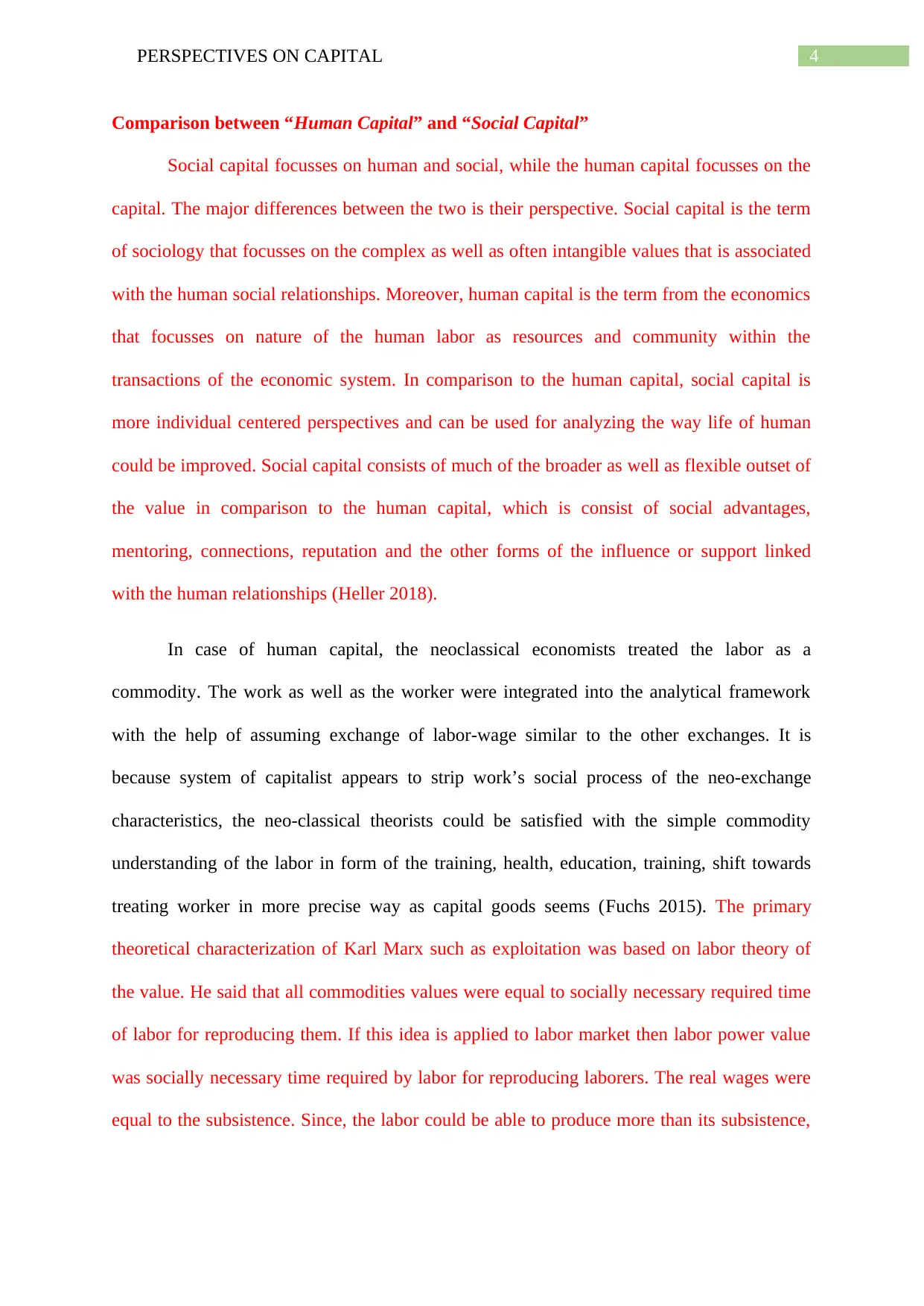
4PERSPECTIVES ON CAPITAL
Comparison between “Human Capital” and “Social Capital”
Social capital focusses on human and social, while the human capital focusses on the
capital. The major differences between the two is their perspective. Social capital is the term
of sociology that focusses on the complex as well as often intangible values that is associated
with the human social relationships. Moreover, human capital is the term from the economics
that focusses on nature of the human labor as resources and community within the
transactions of the economic system. In comparison to the human capital, social capital is
more individual centered perspectives and can be used for analyzing the way life of human
could be improved. Social capital consists of much of the broader as well as flexible outset of
the value in comparison to the human capital, which is consist of social advantages,
mentoring, connections, reputation and the other forms of the influence or support linked
with the human relationships (Heller 2018).
In case of human capital, the neoclassical economists treated the labor as a
commodity. The work as well as the worker were integrated into the analytical framework
with the help of assuming exchange of labor-wage similar to the other exchanges. It is
because system of capitalist appears to strip work’s social process of the neo-exchange
characteristics, the neo-classical theorists could be satisfied with the simple commodity
understanding of the labor in form of the training, health, education, training, shift towards
treating worker in more precise way as capital goods seems (Fuchs 2015). The primary
theoretical characterization of Karl Marx such as exploitation was based on labor theory of
the value. He said that all commodities values were equal to socially necessary required time
of labor for reproducing them. If this idea is applied to labor market then labor power value
was socially necessary time required by labor for reproducing laborers. The real wages were
equal to the subsistence. Since, the labor could be able to produce more than its subsistence,
Comparison between “Human Capital” and “Social Capital”
Social capital focusses on human and social, while the human capital focusses on the
capital. The major differences between the two is their perspective. Social capital is the term
of sociology that focusses on the complex as well as often intangible values that is associated
with the human social relationships. Moreover, human capital is the term from the economics
that focusses on nature of the human labor as resources and community within the
transactions of the economic system. In comparison to the human capital, social capital is
more individual centered perspectives and can be used for analyzing the way life of human
could be improved. Social capital consists of much of the broader as well as flexible outset of
the value in comparison to the human capital, which is consist of social advantages,
mentoring, connections, reputation and the other forms of the influence or support linked
with the human relationships (Heller 2018).
In case of human capital, the neoclassical economists treated the labor as a
commodity. The work as well as the worker were integrated into the analytical framework
with the help of assuming exchange of labor-wage similar to the other exchanges. It is
because system of capitalist appears to strip work’s social process of the neo-exchange
characteristics, the neo-classical theorists could be satisfied with the simple commodity
understanding of the labor in form of the training, health, education, training, shift towards
treating worker in more precise way as capital goods seems (Fuchs 2015). The primary
theoretical characterization of Karl Marx such as exploitation was based on labor theory of
the value. He said that all commodities values were equal to socially necessary required time
of labor for reproducing them. If this idea is applied to labor market then labor power value
was socially necessary time required by labor for reproducing laborers. The real wages were
equal to the subsistence. Since, the labor could be able to produce more than its subsistence,
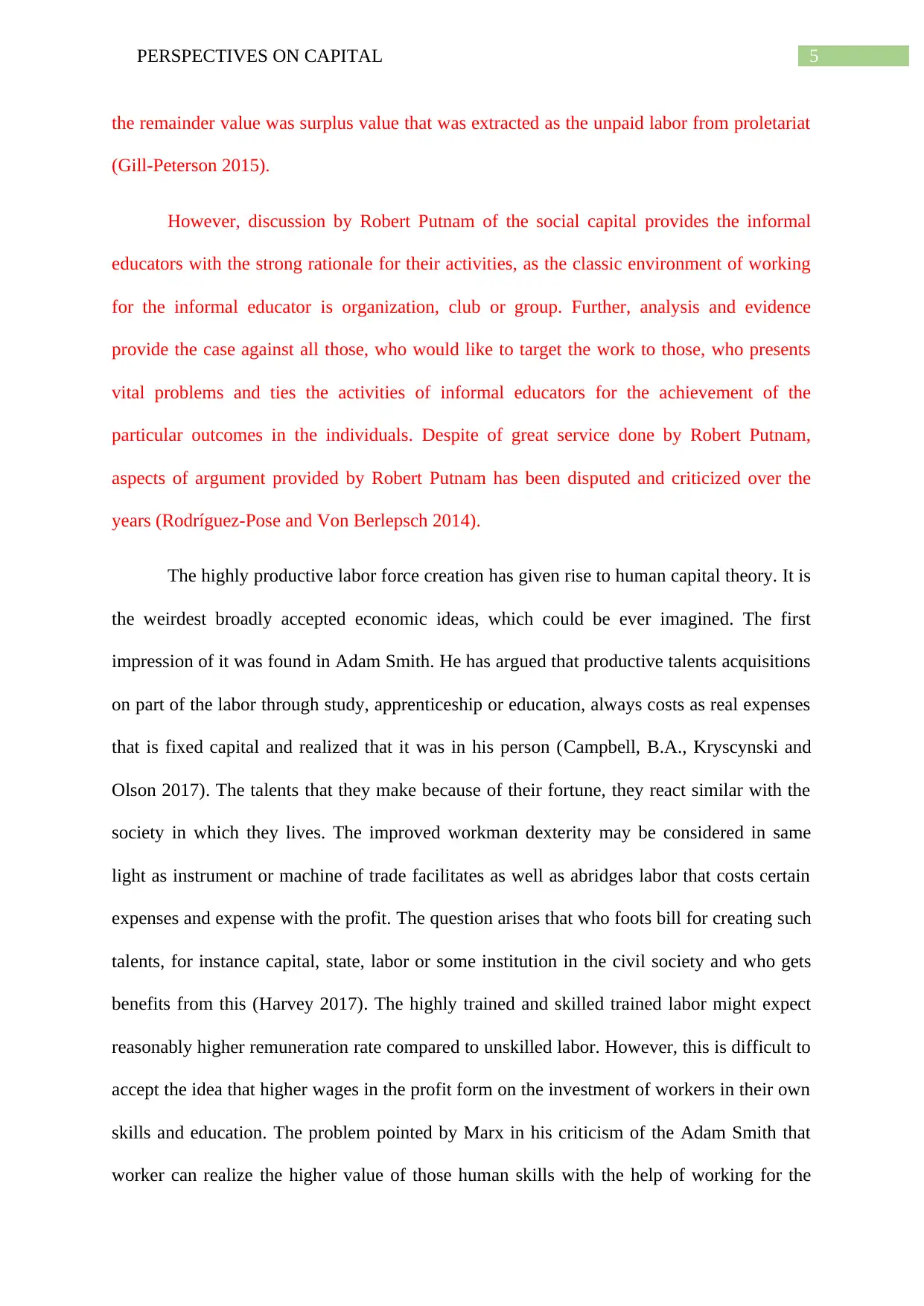
5PERSPECTIVES ON CAPITAL
the remainder value was surplus value that was extracted as the unpaid labor from proletariat
(Gill-Peterson 2015).
However, discussion by Robert Putnam of the social capital provides the informal
educators with the strong rationale for their activities, as the classic environment of working
for the informal educator is organization, club or group. Further, analysis and evidence
provide the case against all those, who would like to target the work to those, who presents
vital problems and ties the activities of informal educators for the achievement of the
particular outcomes in the individuals. Despite of great service done by Robert Putnam,
aspects of argument provided by Robert Putnam has been disputed and criticized over the
years (Rodríguez-Pose and Von Berlepsch 2014).
The highly productive labor force creation has given rise to human capital theory. It is
the weirdest broadly accepted economic ideas, which could be ever imagined. The first
impression of it was found in Adam Smith. He has argued that productive talents acquisitions
on part of the labor through study, apprenticeship or education, always costs as real expenses
that is fixed capital and realized that it was in his person (Campbell, B.A., Kryscynski and
Olson 2017). The talents that they make because of their fortune, they react similar with the
society in which they lives. The improved workman dexterity may be considered in same
light as instrument or machine of trade facilitates as well as abridges labor that costs certain
expenses and expense with the profit. The question arises that who foots bill for creating such
talents, for instance capital, state, labor or some institution in the civil society and who gets
benefits from this (Harvey 2017). The highly trained and skilled trained labor might expect
reasonably higher remuneration rate compared to unskilled labor. However, this is difficult to
accept the idea that higher wages in the profit form on the investment of workers in their own
skills and education. The problem pointed by Marx in his criticism of the Adam Smith that
worker can realize the higher value of those human skills with the help of working for the
the remainder value was surplus value that was extracted as the unpaid labor from proletariat
(Gill-Peterson 2015).
However, discussion by Robert Putnam of the social capital provides the informal
educators with the strong rationale for their activities, as the classic environment of working
for the informal educator is organization, club or group. Further, analysis and evidence
provide the case against all those, who would like to target the work to those, who presents
vital problems and ties the activities of informal educators for the achievement of the
particular outcomes in the individuals. Despite of great service done by Robert Putnam,
aspects of argument provided by Robert Putnam has been disputed and criticized over the
years (Rodríguez-Pose and Von Berlepsch 2014).
The highly productive labor force creation has given rise to human capital theory. It is
the weirdest broadly accepted economic ideas, which could be ever imagined. The first
impression of it was found in Adam Smith. He has argued that productive talents acquisitions
on part of the labor through study, apprenticeship or education, always costs as real expenses
that is fixed capital and realized that it was in his person (Campbell, B.A., Kryscynski and
Olson 2017). The talents that they make because of their fortune, they react similar with the
society in which they lives. The improved workman dexterity may be considered in same
light as instrument or machine of trade facilitates as well as abridges labor that costs certain
expenses and expense with the profit. The question arises that who foots bill for creating such
talents, for instance capital, state, labor or some institution in the civil society and who gets
benefits from this (Harvey 2017). The highly trained and skilled trained labor might expect
reasonably higher remuneration rate compared to unskilled labor. However, this is difficult to
accept the idea that higher wages in the profit form on the investment of workers in their own
skills and education. The problem pointed by Marx in his criticism of the Adam Smith that
worker can realize the higher value of those human skills with the help of working for the
⊘ This is a preview!⊘
Do you want full access?
Subscribe today to unlock all pages.

Trusted by 1+ million students worldwide
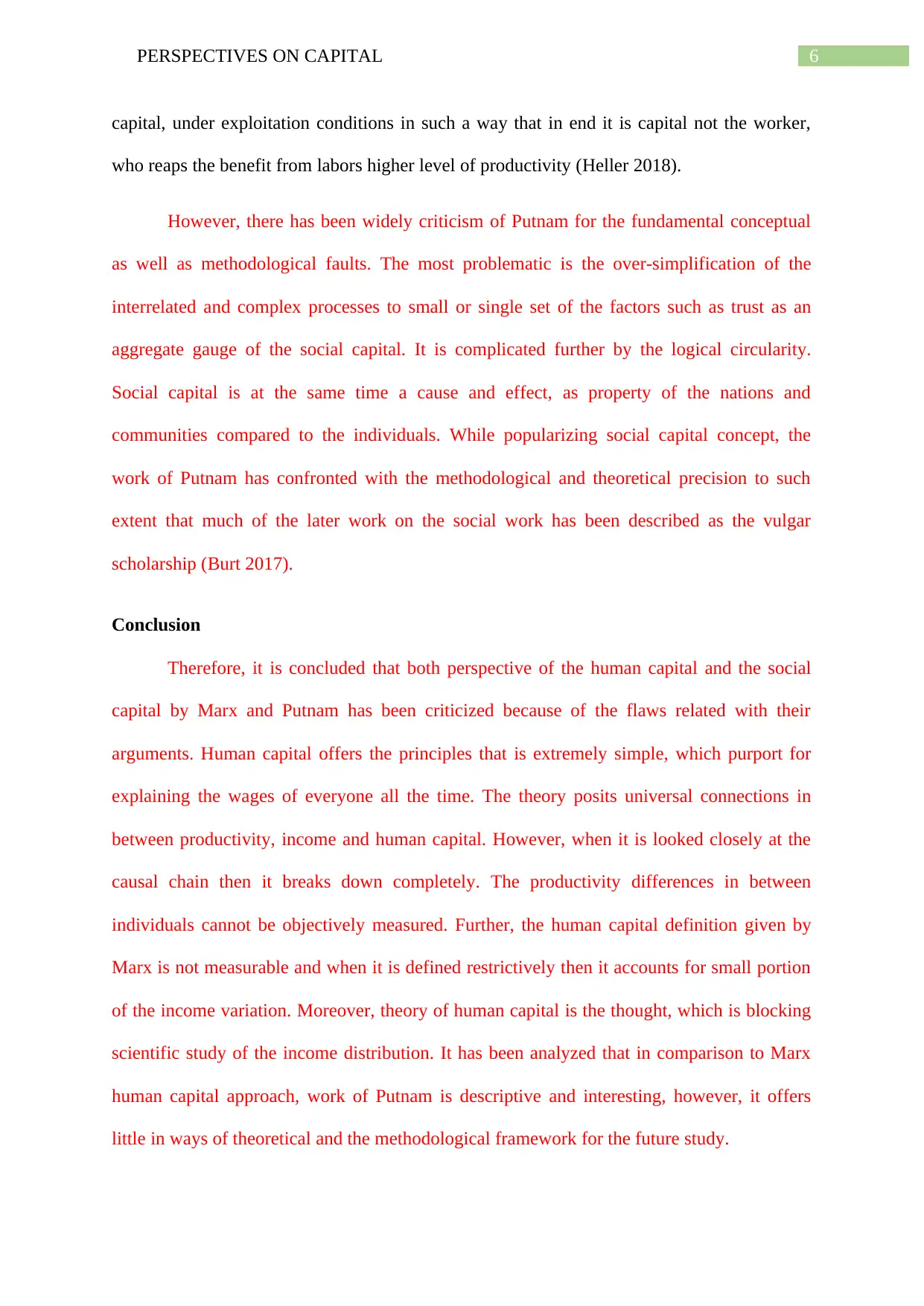
6PERSPECTIVES ON CAPITAL
capital, under exploitation conditions in such a way that in end it is capital not the worker,
who reaps the benefit from labors higher level of productivity (Heller 2018).
However, there has been widely criticism of Putnam for the fundamental conceptual
as well as methodological faults. The most problematic is the over-simplification of the
interrelated and complex processes to small or single set of the factors such as trust as an
aggregate gauge of the social capital. It is complicated further by the logical circularity.
Social capital is at the same time a cause and effect, as property of the nations and
communities compared to the individuals. While popularizing social capital concept, the
work of Putnam has confronted with the methodological and theoretical precision to such
extent that much of the later work on the social work has been described as the vulgar
scholarship (Burt 2017).
Conclusion
Therefore, it is concluded that both perspective of the human capital and the social
capital by Marx and Putnam has been criticized because of the flaws related with their
arguments. Human capital offers the principles that is extremely simple, which purport for
explaining the wages of everyone all the time. The theory posits universal connections in
between productivity, income and human capital. However, when it is looked closely at the
causal chain then it breaks down completely. The productivity differences in between
individuals cannot be objectively measured. Further, the human capital definition given by
Marx is not measurable and when it is defined restrictively then it accounts for small portion
of the income variation. Moreover, theory of human capital is the thought, which is blocking
scientific study of the income distribution. It has been analyzed that in comparison to Marx
human capital approach, work of Putnam is descriptive and interesting, however, it offers
little in ways of theoretical and the methodological framework for the future study.
capital, under exploitation conditions in such a way that in end it is capital not the worker,
who reaps the benefit from labors higher level of productivity (Heller 2018).
However, there has been widely criticism of Putnam for the fundamental conceptual
as well as methodological faults. The most problematic is the over-simplification of the
interrelated and complex processes to small or single set of the factors such as trust as an
aggregate gauge of the social capital. It is complicated further by the logical circularity.
Social capital is at the same time a cause and effect, as property of the nations and
communities compared to the individuals. While popularizing social capital concept, the
work of Putnam has confronted with the methodological and theoretical precision to such
extent that much of the later work on the social work has been described as the vulgar
scholarship (Burt 2017).
Conclusion
Therefore, it is concluded that both perspective of the human capital and the social
capital by Marx and Putnam has been criticized because of the flaws related with their
arguments. Human capital offers the principles that is extremely simple, which purport for
explaining the wages of everyone all the time. The theory posits universal connections in
between productivity, income and human capital. However, when it is looked closely at the
causal chain then it breaks down completely. The productivity differences in between
individuals cannot be objectively measured. Further, the human capital definition given by
Marx is not measurable and when it is defined restrictively then it accounts for small portion
of the income variation. Moreover, theory of human capital is the thought, which is blocking
scientific study of the income distribution. It has been analyzed that in comparison to Marx
human capital approach, work of Putnam is descriptive and interesting, however, it offers
little in ways of theoretical and the methodological framework for the future study.
Paraphrase This Document
Need a fresh take? Get an instant paraphrase of this document with our AI Paraphraser

7PERSPECTIVES ON CAPITAL

8PERSPECTIVES ON CAPITAL
Reference
Burt, R.S., 2017. Structural holes versus network closure as social capital. In Social
capital (pp. 31-56). Routledge.
Campbell, B.A., Kryscynski, D. and Olson, D.M., 2017. Bridging strategic human capital and
employee entrepreneurship research: A labor market frictions approach. Strategic
Entrepreneurship Journal, 11(3), pp.344-356.
Fleming, P., 2017. The human capital hoax: Work, debt and insecurity in the era of
Uberization. Organization Studies, 38(5), pp.691-709.
Fuchs, C., 2015. Reading Marx in the Information Age: A Media and Communication Studies
Perspective on Capital Volume 1. Routledge.
Gill-Peterson, J., 2015. The value of the future: The child as human capital and the neoliberal
labor of race. Women's Studies Quarterly, 43(1/2), pp.181-196.
Harvey, D., 2017. Marx, capital, and the madness of economic reason. Oxford University
Press.
Heller, A., 2018. The theory of need in Marx. Verso Books.
Lordon, F., 2014. Willing slaves of capital: Spinoza and Marx on desire. Verso Trade.
Marx, B.M. and Turner, L.J., 2018. Borrowing trouble? human capital investment with opt-in
costs and implications for the effectiveness of grant aid. American Economic Journal:
Applied Economics, 10(2), pp.163-201.
Rodríguez-Pose, A. and Von Berlepsch, V., 2014. Social capital and individual happiness in
Europe. Journal of Happiness Studies, 15(2), pp.357-386.
Reference
Burt, R.S., 2017. Structural holes versus network closure as social capital. In Social
capital (pp. 31-56). Routledge.
Campbell, B.A., Kryscynski, D. and Olson, D.M., 2017. Bridging strategic human capital and
employee entrepreneurship research: A labor market frictions approach. Strategic
Entrepreneurship Journal, 11(3), pp.344-356.
Fleming, P., 2017. The human capital hoax: Work, debt and insecurity in the era of
Uberization. Organization Studies, 38(5), pp.691-709.
Fuchs, C., 2015. Reading Marx in the Information Age: A Media and Communication Studies
Perspective on Capital Volume 1. Routledge.
Gill-Peterson, J., 2015. The value of the future: The child as human capital and the neoliberal
labor of race. Women's Studies Quarterly, 43(1/2), pp.181-196.
Harvey, D., 2017. Marx, capital, and the madness of economic reason. Oxford University
Press.
Heller, A., 2018. The theory of need in Marx. Verso Books.
Lordon, F., 2014. Willing slaves of capital: Spinoza and Marx on desire. Verso Trade.
Marx, B.M. and Turner, L.J., 2018. Borrowing trouble? human capital investment with opt-in
costs and implications for the effectiveness of grant aid. American Economic Journal:
Applied Economics, 10(2), pp.163-201.
Rodríguez-Pose, A. and Von Berlepsch, V., 2014. Social capital and individual happiness in
Europe. Journal of Happiness Studies, 15(2), pp.357-386.
⊘ This is a preview!⊘
Do you want full access?
Subscribe today to unlock all pages.

Trusted by 1+ million students worldwide
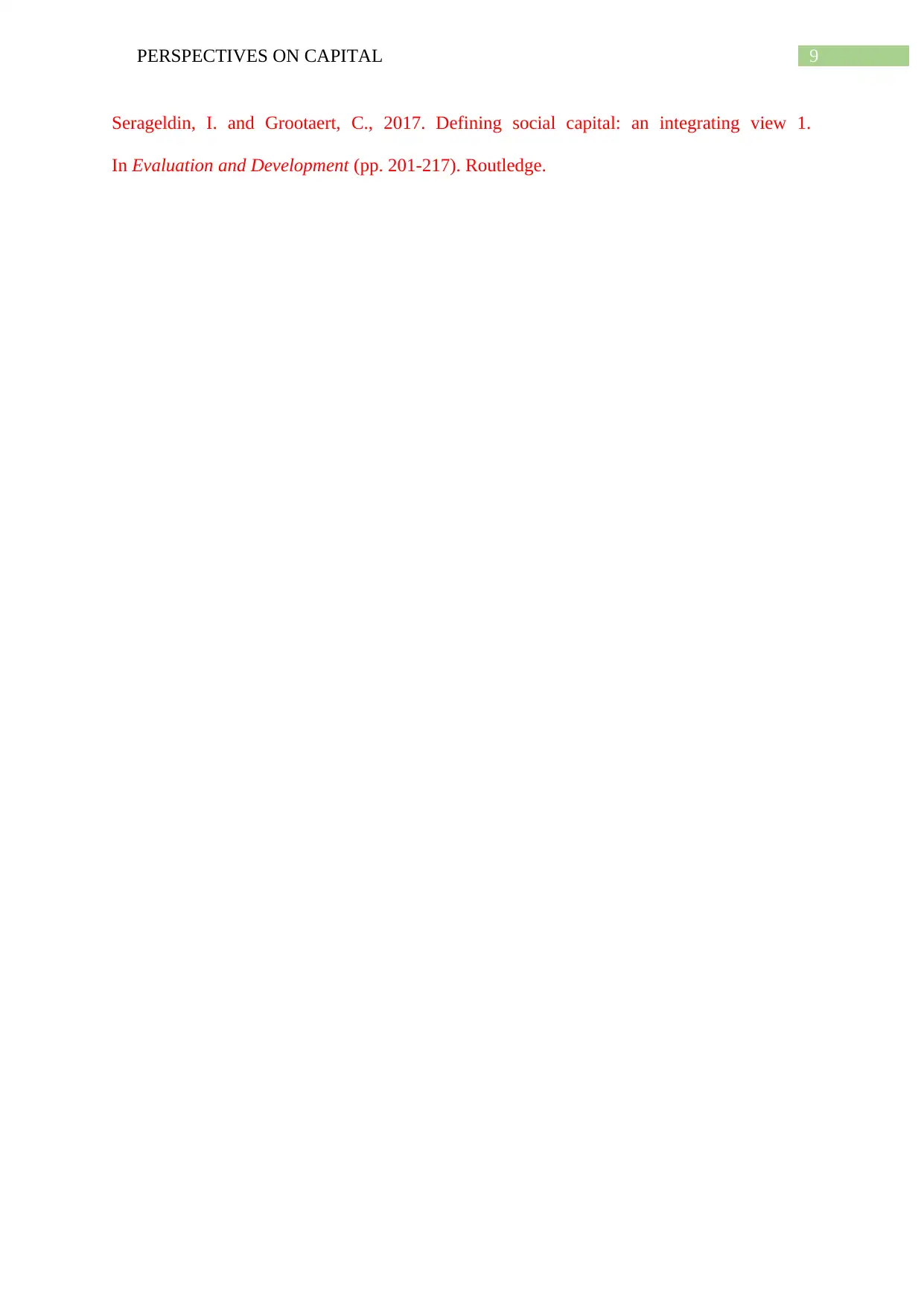
9PERSPECTIVES ON CAPITAL
Serageldin, I. and Grootaert, C., 2017. Defining social capital: an integrating view 1.
In Evaluation and Development (pp. 201-217). Routledge.
Serageldin, I. and Grootaert, C., 2017. Defining social capital: an integrating view 1.
In Evaluation and Development (pp. 201-217). Routledge.
1 out of 10
Your All-in-One AI-Powered Toolkit for Academic Success.
+13062052269
info@desklib.com
Available 24*7 on WhatsApp / Email
![[object Object]](/_next/static/media/star-bottom.7253800d.svg)
Unlock your academic potential
Copyright © 2020–2025 A2Z Services. All Rights Reserved. Developed and managed by ZUCOL.